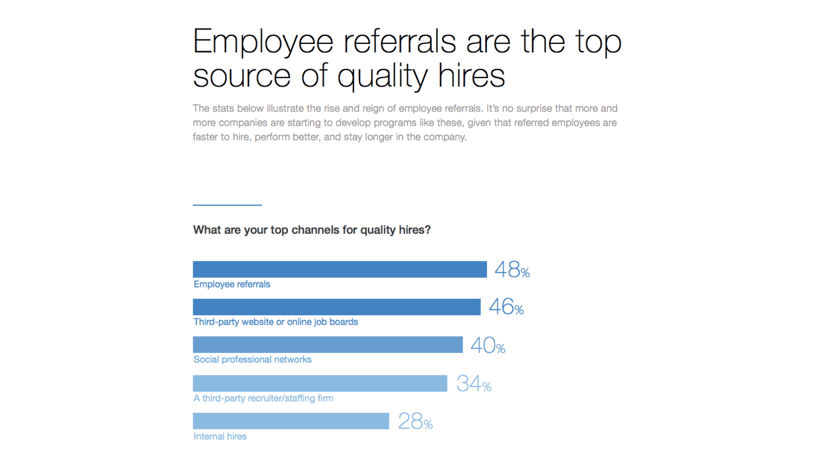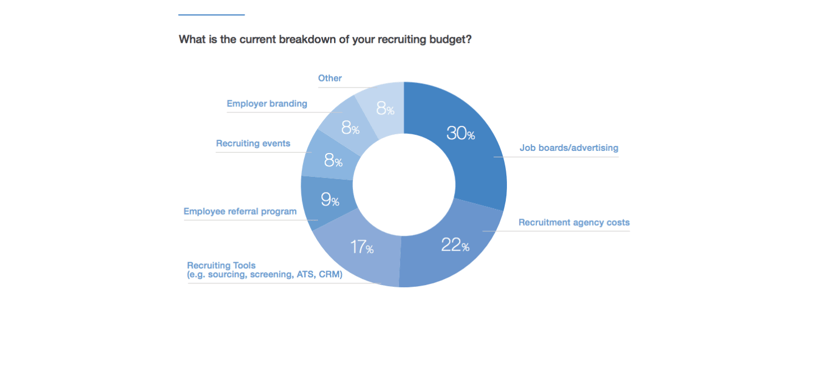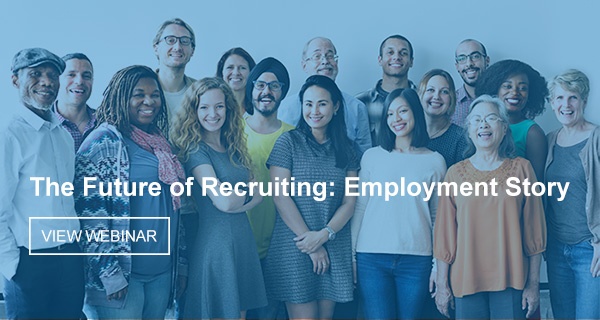
Most companies have an employee referral program. Roughly two-thirds, or 63 percent, of organizations have a documented referral program, and on average 23% of hires originate from a referral. Linkedin even cited referrals as the best source of talent for companies in their 2017 Global Recruiting Trends report. However, companies are systematically under-investing in the success of their referral program.

Source: LinkedIn 2017 Global Recruiting Trends report, p 13.

Source: LinkedIn 2017 Global Recruiting Trends report, p 18.
At the same time, social selling has become all the rage in the B2B sales world. Why has recruiting not caught up? After working for years to help companies improve their referral programs, here are the biggest challenges we’ve seen to unlocking the power of employee’s networks when hiring.
Challenges with employee engagement
Only 10% - 15% of employee’s actually make a referral. Most companies pay a referral bonus to incentivize participation, but a growing body of research shows cash bonuses are not effective in engaging employees in this type of activity. What does seem to work, however, is intrinsically motivating employees by making them feel like an important member of a progressive work community. Managers should make special efforts to create a welcoming work environment that addresses their employee’s needs for training and development along their career path. If employees are genuinely satisfied with their work environment, they will naturally want to spread the word to their friends and contacts who may also be a good fit for the company.
Low quality of referrals
When employees do refer, it’s most often people who are at the top of mind, people they may be familiar with but who may not be the most qualified person for the position. Low quality referrals may actually do more harm than good because it will waste the recruiters’ time in having to qualify candidates, therefore prolonging time to fill. It’s painful enough to waste time on poor-fit candidates and even more discouraging for recruiters to follow-up with employees and explain to them why their referral did not make it through the hiring process. As the common phrase goes: “A players refer A players, and B players refer C players.”
While it’s important to encourage and incentivize employees to make referrals, employees may not have the clearest idea of what to look for in a candidate or what the company ultimately needs in their next hire, and therefore may actually waste more of the recruiter’s time if they are not properly trained. What’s the solution? Talk to your employees and maybe hold a company-wide training meeting to update employees on how to spot the best candidates in their network. Referrals are a part of team-based hiring, and the best hiring comes from teams that are united in their goals and have a clear view of their overall hiring strategy.
Suggested article: How to keep your best employees happy
Manual processes are unwieldy
Candidate submission, plugging into the ATS, and follow-up are usually handled manually, and are therefore are clunky and time-consuming. Referral bonus payout is especially painful for companies, especially if they’ve set a very high cash bonus for referrals in the hopes of incentivizing more referrals. Furthermore, coordination with payroll is manual, attribution can get complicated, and often times the referral bonus is delivered months after the initial referral is made, making it an overall very frustrating experience for the employees and recruiters involved. It is in most company’s best interest to join the new millennium and integrate HR software that helps automate and facilitate the entire referral process from sourcing, to outreach, to applicant tracking, and finally to rewards.
Thinking of social recruiting only as employee referrals
Employee referrals are just one example of social hiring, and there are many underlying reasons for why social hiring works so well for companies. For one, a warm introduction through an employee referral gives instant credibility, since the candidate is more likely to trust the recommendation of someone in his or her network. This village effect leads to a higher candidate response rate, a more efficient hiring funnel, faster time-to-hire, and higher close rate once an offer is extended. For Millennials especially, working for a company that fit their values is very important to them. Hence, knowing that a trusted friend or colleague in their network is already at the company will provide a stronger case for them to join since it is more likely that they will be a good fit at the company.
One of the largest benefits of employee referrals is a better fit hire, and it doesn’t take a genius to know that a better fit employee is much more likely to achieve better long-term success than an employee that is poor-fit. Referrals are just one way for current employees to preapprove and prescreen candidates on the company’s behalf. Having previously interacted with the candidates either in school, work, or in social gatherings, the employee has preexisting knowledge of the candidate’s work history and style and are best placed to judge their ability to be successful at a company.
Social hiring is the key to a company’s success
For companies competing in the rocky landscape of the knowledge economy, making the right hire can be the difference between success and failure. Most companies are failing to invest in their best source of talent--employee referral programs. All of these benefits of a faster time-to-fill, better-fit employee, and more long term success are present in an employee referral program. However, just the pure mechanics of getting someone to refer a candidate is not enough to receive the full benefits. Instead, companies need to think about how to design their hiring structure to maximize the underlying causes of referral benefits, i.e. social hiring or team-based hiring. This includes properly educating their employees on how to spot the best candidates in their network and how to use technology to seamlessly refer candidates to the company. Most importantly, it’s up to the company to properly incentivize their employees to make referrals, not just with cash bonuses, but also by nurturing a progressive work environment that employees want to tell their friends and network about. It’s not just the referral programs themselves that will produce success, rather, it’s the entire company from the recruiters to the employees to the managers that must create the circumstances and positive synergy within their team to effectively reach out and engage the best candidates via team-based hiring.
Suggested article: How to create an employee referral campaign
***
About the author: Cristina McComic is the Head of Content at Simppler, a recruiting technology company that turbocharges employee referral hiring, leading to faster & more cost effective hiring, better business performance, and lower attrition. Bi-coastal and international, Cristina holds a Bachelors degree from Vassar College in New York and a Masters Degree in Chinese Business Law from Fudan University in Shanghai, China. Having lived in Shanghai for 5 years and traveled all around the globe, Cristina brings a range of international experiences to the hiring industry. As a bona-fide "people-person", Cristina is excited to bring a fresh perspective to this people-industry.














